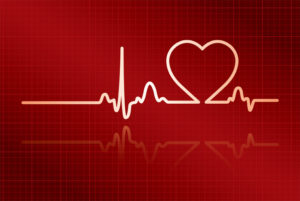 I have always had a fascination for EKG tracings. My desire to know what the little scribbles on graph paper meant led me to take a critical care certification class at my hospital so I could work in CCU if needed, and the step down unit Telemetry so I could play with these fascinating items at work. I learned a lot in that course but it was dry and I did more memorizing than actual learning. I got signed off to take Advanced Cardiac Life Support after this and I decided to take it with an outside company rather than in the hospital. The in-house instructor had the reputation of failing everyone during the “mega code” including doctors. At that time, ACLS was extremely difficult and a feather in the hat of anyone who could pass it.
I have always had a fascination for EKG tracings. My desire to know what the little scribbles on graph paper meant led me to take a critical care certification class at my hospital so I could work in CCU if needed, and the step down unit Telemetry so I could play with these fascinating items at work. I learned a lot in that course but it was dry and I did more memorizing than actual learning. I got signed off to take Advanced Cardiac Life Support after this and I decided to take it with an outside company rather than in the hospital. The in-house instructor had the reputation of failing everyone during the “mega code” including doctors. At that time, ACLS was extremely difficult and a feather in the hat of anyone who could pass it.
I took the course under Dr. David Doernbach, a fascinating and funny man who had the knack of making the technical funny and a discerning that clinicians who understood what they were doing and why made for much better patient outcomes than patients who were treated with memorized algorithms and protocols.
I sat with my mouth hanging open as Dr. Dave presented a slide show that showed some of the first EKG machines, monstrous contraptions that took up entire rooms with the patients sitting with their feet in buckets of salt water and nurses with bat wing starched hats rolled out soot tracings onto paper so the scribbles could be studied.
But if you think that is archaic, consider this: In 1838 Carlo Matteucci, a professor of Physics at Pisa University invented what was called a “rehoscopic frog” where the nerve of a dead frog was used as the electrical sensor, causing the dead muscle to twitch to show electrical activity! How gross! Don’t you appreciate your cardiologists nice clean office now?

That was it for me, thanks to Dr. Dave, I will forever be hooked on graph paper with scribbles on it. And we have come such a long way from the 1788 report of the Humane Society: ” An Essay on the Recovery of the Apparently Dead” in London, to Augustus Waller demonstrating EKG’s on his dog, Jimmy, standing in four jars of saline for the show at St. Mary’s Medical School in 1889. The first portable EKG, a “Holter Monitor”, was a 75 pound backpack invented by Dr. Norman Holter in 1949. I mean seriously, if you can handle trudging around with a 75 pound backpack your heart is probably fine. At least for now!
So that brings us to a modern EKG– this is a normal rhythm strip. 
You have your first little “bump” called a “p-wave” is the electrical activity going down the heart muscle to stimulate the heart to action, the large “wave” after that is the “QRS” that shows the ventricles contracting to pump blood out of the heart. The last little bump is your t-wave as the heart depolarizes to perform this miracle all over again. The boxes on the graph paper show time, going horizontally, and measures voltage, or strength of action, horizontally. This is an extremely SIMPLIFIED explanation but to me it speaks to much more than the cardiac cycle. We have an idea, a thought, that leads to an action then a resting period, and we get ready to do it again. impulse- action- rest -repeat-impulse-action-rest-repeat…
This is the rhythm of LIFE.
What can happen when your rhythm is off?
Well on an EKG if you have no p-wave, you have atrial fibrillation and your ventricular action is often rapid and irregular. In your life if you have no plan your actions are thoughtless and often irregular…
Think about it!
And there are so many variations to consider, apply them to your life by name: premature atrial contractions= premature thoughts we may react to with unplanned actions OR premature ventricular contractions, an action with no thought to guide it. These can become more frequent and lead to very dangerous rhythms/actions. If you have a proper p-wave then too much time before action from the ventricle you have a heart block. Depending on how long the interval is between p-wave and action shows the severity of your heart block.  Are you blocking an action you need to take in life? Consider and treat this now before it ends you. Bradycardia or tachycardia describes a heart rate that is either to slow or to fast, either one can decrease cardiac output, or measurable action in your life. Is your life moving along at the correct pace? Why or why not? What is causing the slow down or acceleration? Better get with your cardiologist and find out.
Are you blocking an action you need to take in life? Consider and treat this now before it ends you. Bradycardia or tachycardia describes a heart rate that is either to slow or to fast, either one can decrease cardiac output, or measurable action in your life. Is your life moving along at the correct pace? Why or why not? What is causing the slow down or acceleration? Better get with your cardiologist and find out.
This one is familiar to anyone who has ever seen a medical drama on TV.  V-TACH! or “V-TACH! Charge the paddles!” and the gorgeous TV doctors and model nurses slap the defibrillator on the patient, yell, “CLEAR” and the patient dramatically arches off the gurney, everyone looks at the monitor and see’s a perfect sinus rhythm, everyone smiles and the patient smiles too. Especially if the patient is a female and the TV doc is VERY cute! This never fails to make me laugh!
V-TACH! or “V-TACH! Charge the paddles!” and the gorgeous TV doctors and model nurses slap the defibrillator on the patient, yell, “CLEAR” and the patient dramatically arches off the gurney, everyone looks at the monitor and see’s a perfect sinus rhythm, everyone smiles and the patient smiles too. Especially if the patient is a female and the TV doc is VERY cute! This never fails to make me laugh!
In real life, this is an extremely serious situation with scant minutes for correction. The heart muscle is “fibrillating”, in other words it is moving, but the action is not producing any cardiac output. The heart is “quivering” but not pumping blood, there is no life-sustaining action here at all. This often has tragic outcomes…
Socrates stated, “The unexamined life is not worth living.” We can look at our lives like an EKG tracing, do we have a p-wave, a plan, take only the correct amount of time and have appropriate actions? Then do we rest and repolarize so we can do it again?
I like to sit down with my journal and think on paper. This helps me focus and see what is going on in my life, what is working, what is not, what I think should be going on and what I think I should be doing. In this way I can follow the advice of the Apostle Peter: “Seeing that ye look for such things, be diligent that ye may be found of Him in peace” 2 Peter 3:14. My way may not work for you but I encourage you to find a way that does. Then do it!
Take good care of your heart and it will take care of you.
*** Nothing in this post is intended to replace medical advice from a doctor! Educate yourself on the signs and symptoms of a heart attack or stroke http://www.heart.org/HEARTORG/Conditions/911-Warnings-Signs-of-a-Heart-Attack_UCM_305346_SubHomePage.jsp IF you even think you are having a problem– call FIRST, call FAST, call 911! (line stolen from Dr. Dave!) Believe me the ER is full of doctors and nurses who can’t wait to take care of you. It’s what we do– even if our doctors are not that cute or the nurses don’t look like models at the end of a 12+ hour shift! ***
If you are a medical professional who is tired of boring ACLS classes or dry EKG lectures I can not recommend Dr. Dave’s programs highly enough. He is simply the best, and funniest! http://www.vsu.com/
You could also work through this book and really show out at work parties! Just don’t forget the real life mantra, “treat your pt. NOT the monitor!”
 (comment if you know this one)
(comment if you know this one)
xx00- Alana



Amen-Amein Sister in Christ Jesus-Yeshua!!
Thank you Kristi! Have a blessed Easter!
My mother suffered from heart problems for many years, so she had countless EKGs. One of her doctor’s pointed out to us that each heart has only a set number of beats. Only God though knows that number. <3
Indeed! God knows the number of beats and has the hairs on our heads counted! We praise Him because we are fearfully and wonderfully made!